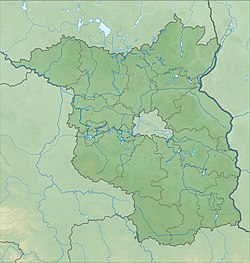Latène burial ground near Cammer
Coordinates: 52 ° 14 ′ 0 ″ N , 12 ° 41 ′ 0 ″ E
| Latène burial ground near Cammer | ||
|---|---|---|
| location | Brandenburg , Germany | |
| Location | Cammer | |
|
|
||
| When | Middle and late Latène period urn burial ground | |
| Where | Cammer , Fläming / Brandenburg | |
The Latène grave field near Cammer , a Middle and Late Latène Age urn grave field with 91 secured graves, was excavated in 1926 by Karl-Heinrich Marschalleck . The grave field is located in the historic landscape of the Zauche near Cammer , a district of the municipality of Planebruch in the Brandenburg district of Potsdam-Mittelmark in Fläming .
Find description
The latène period cemetery near Cammer was excavated in 1926 by Karl-Heinrich Marschalleck. The excavations in the Middle and Late La Tène Age urn grave field resulted in a total of 91 secured graves, but the grave field proved to be partially disturbed during the excavation, so its original extent is not known. The finds include the forms typical of this time. In addition to ceramics, there were also various types of belt hooks and fibulae from the Latène period . A few sailing earrings and goiter needles complete the latène period finds.
Interpretation of the finds
On the basis of the rich and diverse finds, Marschalleck was able to demonstrate the seamless transition from the early La Tène period primers to the early and middle La Tène period primers. The numerous forms of fibulae from the late La Tène period testify to the continuous occupancy of this burial ground, probably from an early stage of the middle pre-Roman Iron Age to the decades around the turn of the ages. Marschallek was able to underpin the (relatively chronological) occupation sequence of the investigated area in the burial field determined on the basis of the fibula shapes, horizontally and stratigraphically, by the order of the burial from east to west. It is noteworthy that the oldest recorded graves could be clearly distinguished from the more recent burials by a later layer of drifting sand.
Remarks
- ↑ See Hans-Jürgen Häßler : Cammer. In: Reallexikon der Germanischen Altertumskunde (RGA). 2nd Edition. Volume 4, Walter de Gruyter, Berlin / New York 1981, ISBN 3-11-006513-4 , p. 324.
literature
- Hans-Jürgen Häßler : Cammer. In: Reallexikon der Germanischen Altertumskunde (RGA). 2nd Edition. Volume 4, Walter de Gruyter, Berlin / New York 1981, ISBN 3-11-006513-4 , p. 324.
- Karl-Heinrich Marschalleck : The Latène grave field near Cammer (Kr. Zauch-Belzig) . In: Prehistoric Journal . tape 18 , 1927, pp. 212-249 .
- Karl Heinrich Marschallek: The chronology of the pre-Roman Iron Age in the Middle Elbe region . Dissertation Tübingen 1928.
